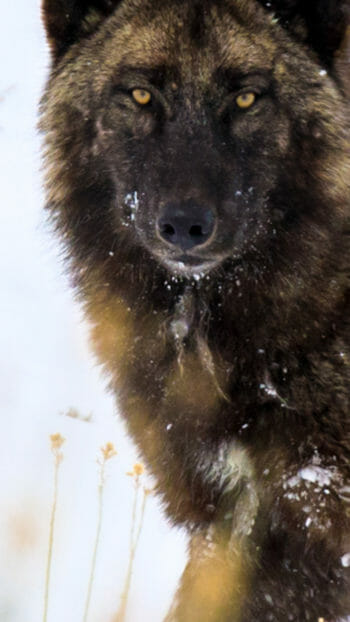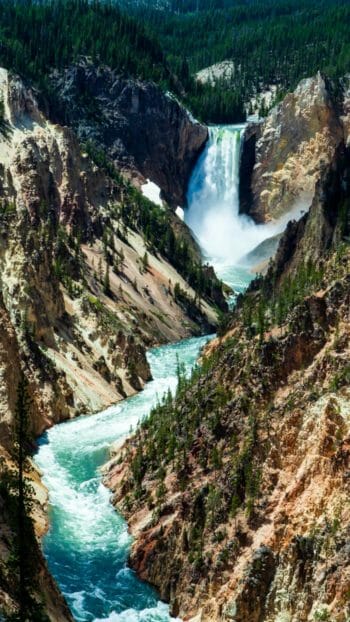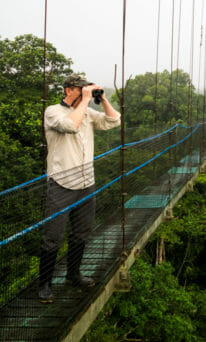In 1926 the last known wolf was killed within the boundary of Yellowstone National Park and in 1943 the last recorded wolf was killed in Wyoming. After nearly 10,000 years on the landscape, a key species and apex predator was gone. Though a few sightings were reported in the years that followed, it is widely agreed that for all intents and purposes wolves were exterminated from the Greater Yellowstone Ecosystem. The systematic extirpation of wolves was done by all means necessary including trapping, poisoning and shooting. The ideal of a predator free landscape made sense in the context of a culture founded on dominion over the natural world as opposed to living in harmony with it. Ranchers didn’t want to lose cattle, hunters feared the loss of game and most everyone agreed that wolves didn’t have much value.
Even the famous conservationist Aldo Leopold agreed with killing wolves until he realized through his direct observations that wolves were valuable to the natural world and health of the ecosystems in which they live. In one of his often quoted passages Leopold laments, “In those days we had never heard of passing up a chance to kill a wolf. In a second we were pumping lead into the pack, but with more excitement than accuracy; how to aim a steep downhill shot is always confusing. When our rifles were empty, the old wolf was down, and a pup was dragging a leg into impassable side-rocks. We reached the old wolf in time to watch a fierce green fire dying in her eyes. I realized then, and have known ever since, that there was something new to me in those eyes—something known only to her and to the mountain. I was young then, and full of trigger-itch; I thought that because fewer wolves meant more deer, that no wolves would mean hunters’ paradise. But after seeing the green fire die, I sensed that neither the wolf nor the mountain agreed with such a view.”

Leopold’s realization and later observations fueled a passion for conservation and a preservation of a wild world that included the wolf. As a more modern perspective began to influence land management decisions, a movement began to reintroduce wolves back into the Greater Yellowstone Ecosystem. Between 1995 and 1997, the Unites States Fish and Wildlife Service, with the help of the National Park Service, released 31 wolves into Yellowstone National Park. The program was so successful that future planned releases were never carried out. The wolf population increased steadily in Yellowstone and peaked at over 175 wolves in 2003. As the habitat within Yellowstone became saturated and well established packs claimed the best territory, younger wolves began branching out in search of new territory. They moved out of Yellowstone in all directions, including to the south where they found the ideal habitat of Jackson Hole.
After the release of wolves into Yellowstone it became apparent that the wildlife tourism associated with wolves was significant. According to one study (Click here to read), wolf watching in 2005 generated around 35 million dollars in revenue for the three states visited for this purpose (Wyoming, Idaho and Montana). 44% of all visitors surveyed in this study listed the wolf as one of the animals they would most like to see, second only to grizzly bears in terms of visitor interest.
As wolves became more established in Grand Teton National Park and Jackson Hole they also became more visible. Jackson Hole, including Grand Teton and the National Elk Refuge, was becoming known as a wolf watching destination to rival Yellowstone and the famous Lamar Valley. There were even wolf dens and rendezvous sites being established in places that visitors could easily watch from a safe distance in their natural environment. Places like Elk Ranch, Willow Flats and the wide expanses of the National Elk Refuge (in winter) were becoming reliable places to find wolves, often doing something interesting like hunting, chasing coyotes or even playing. By the winter of 2011/12 our guests were seeing wolves on about half of our safaris! Though some guide services had already started offering wolf specific tours in Jackson Hole, we had been waiting until the sightings were more reliable and the packs were more established and predictable. It was after the frequent and reliable sightings in 2012 that we started to design and promote wolf watching which we expected to especially benefit our shoulder seasons like spring, fall and winter when the wolf watching was often the best. All of the tour businesses and wildlife photographers agreed that the combination of more wolves living in accessible places was creating unprecedented wolf watching opportunities in Jackson Hole.
Unfortunately the steady increase in the wolf population also led to the delisting of the wolf from protection under the Endangered Species Act in September of 2012. As an endangered species wolves could not be hunted and even control actions for livestock depredation or other nuisance behaviors were more difficult as they had to be approved by federal agents. The fate of the Wyoming wolf was transferred from the US Fish and Wildlife Service, who banned sport hunting and trapping, to the Wyoming Game and Fish Department, who immediately created a trophy hunting and trapping season (and predator control program) targeting any wolves that roamed outside the National Park boundaries.
According to the Game and Fish 2012 Wolf Report, at the end of 2012 at least 277 wolves in 43 packs roamed the wild country of Northwest Wyoming. That was after the loss of 136 wolves that year including 120 at the hand of people. Of those 66 were legally harvested as either trophy animals (permit required) or predators (no permit required), 43 were killed by state or federal agents, 5 were killed by cars, 4 were poached and 3 the cause was unknown. Not only were there significantly less wolves to watch, they had been taught an important lesson – people were dangerous and to be avoided!
This first hunt devastated the wolf watching and photography industry in Jackson Hole and shattered the potential for this multi-million dollar industry to flourish! That winter the wolves vanished from sight. They started hunting and moving at night and were being especially careful to avoid being spotted by people. That winter (2012/13) our guides and guests only saw wolves twice in the entire season! Their disappointment was palpable and our loss of revenue dramatic. Not only was this an entirely new dimension to the wildlife related tourism industry in Jackson Hole, it also coincided with our slow seasons, a time when valley businesses struggle to make sales, fill hotel rooms, restaurant seats and certainly sell wildlife safaris. It was an amazingly sudden shift and a lesson to be learned about our wild neighbors. They are smart! The wolf packs that we are starting to know didn’t lose that many members to the hunt but they saw enough of their family killed to completely avoid us. This negative conditioning will most certainly have an impact on our ability to watch and photograph these wolves for years to come.

Not only was this 35 million dollar a year activity destroyed during one fall hunt, Wyoming Game and Fish lost over $460,000 administering their wolf program in 2012! According to their records they sold 4,287 wolf tags for $107,136.00 but spent 569,271.31 on their wolf management program! Of those sold only 187 tags were for out of state hunters meaning that the vast majority of the program was for Wyoming residents and would have generated very little ancillary income for other businesses (average spends for in-state users are demonstrated to be significantly lower than out-of-state travelers).
In 2013 the interest in tags was even lower with only 2,152 tags sold generating $61,416.00 and only selling tags to 140 out-of-state hunters. After spending $541,594.86 on wolf management in 2013, the Wyoming Game and Fish lost $480,000 administering this one program! It’s no wonder the Wyoming Game and Fish is struggling financially and faced a 2 million dollar budget deficit in 2013 alone. Since 2009 the department has experienced an inflation adjusted decline of 13% according to their website.
Given these facts wouldn’t it make sense to reevaluate the way we value wildlife. Is the old paradigm broken? The idea that just because an animal is no longer officially threatened means we should immediately start killing again it is short sighted and given the numbers downright stupid. Wolves in today’s world are worth more alive than dead – the numbers don’t lie. By Wyoming Game and Fish following this old land management ethos, they are costing our community millions of dollars, wasting taxpayer money and taking away good paying jobs (not to mention encouraging people to come and take away such a valuable resource). It’s time Wyoming Game and Fish recognize that there is a better way to manage wildlife. One that is more profitable, more scientifically sound and one that requires spending a lot less money.
If you agree please send a message to the Wyoming Game and Fish Department and the Wyoming state legislators and let them know your thoughts. The legislative session is just starting and Wyoming Game and Fish budget discussions will be happening soon. Let’s send a clear message that these policies are bad for business and bad for wildlife!
Representative Ruth Ann Petroff
Box 2764
Jackson Wyoming 83001
Ruth.Petroff@wyoleg.gov
Andy Schwartz
PO Box 2654
Jackson Wyoming 83001
schwartzhd23@gmail.com
Senator Christensen
220 West Alta
Alta Wyoming 83414
Leland.Christensen@wyoleg.gov
Director of Wyoming Game and Fish
Scott Talbott
5400 Bishop Boulevard
Cheyenne, Wyoming 82006





